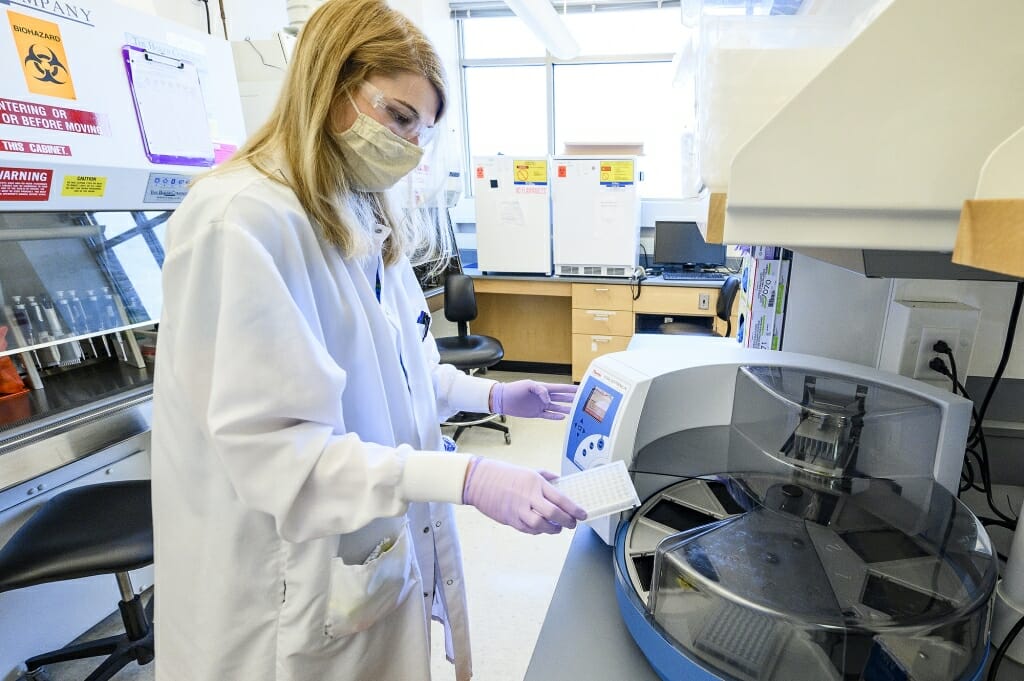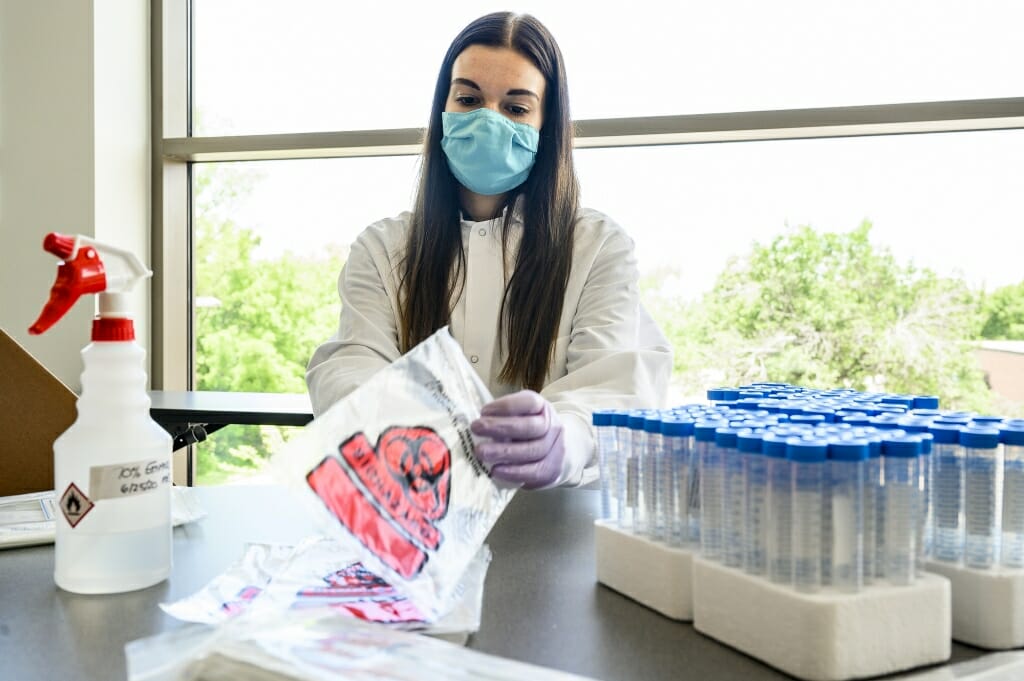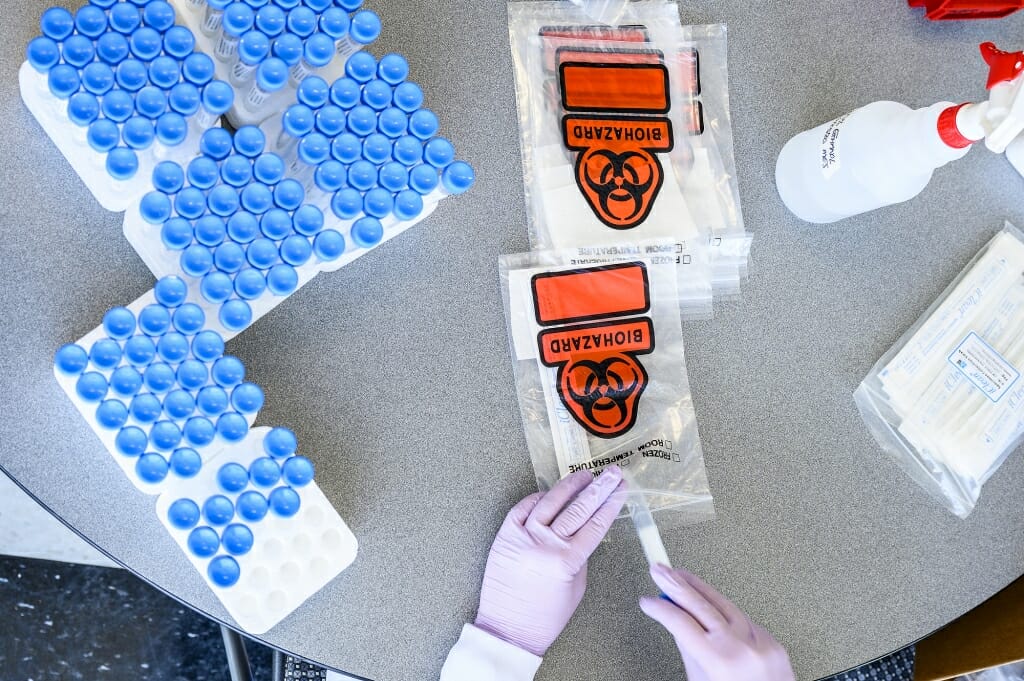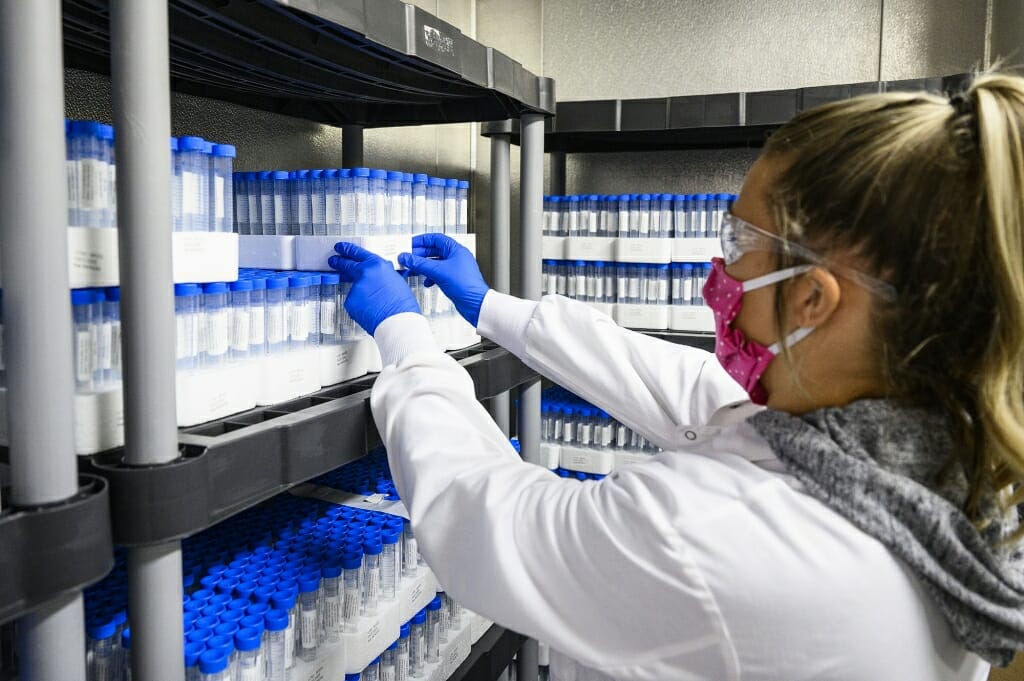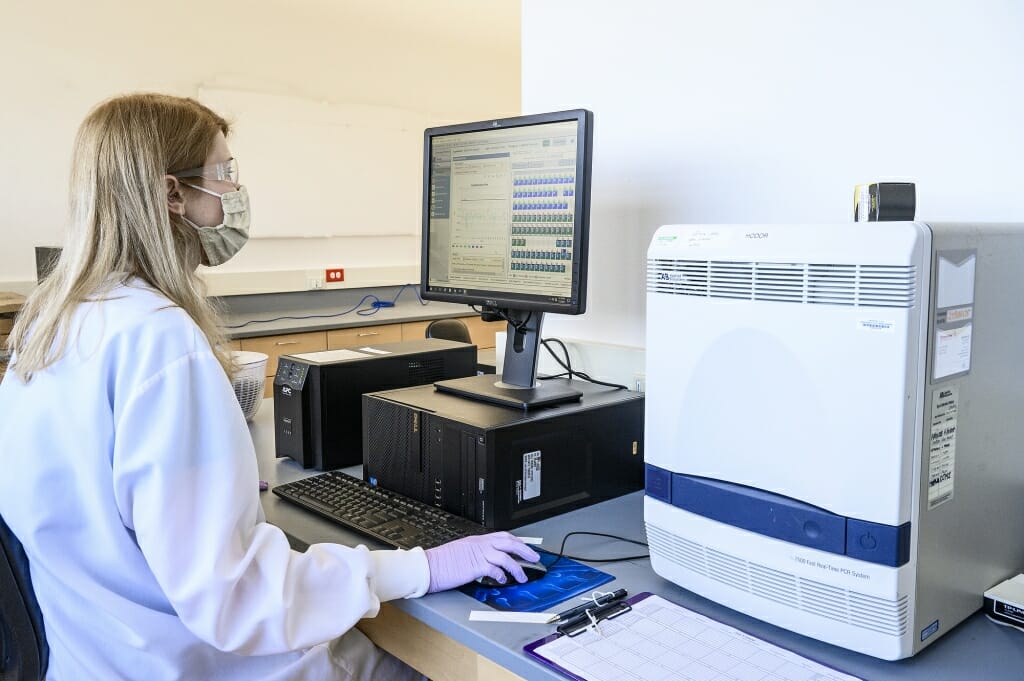UW–Madison establishes free, campus-wide COVID-19 testing to support campus reopening
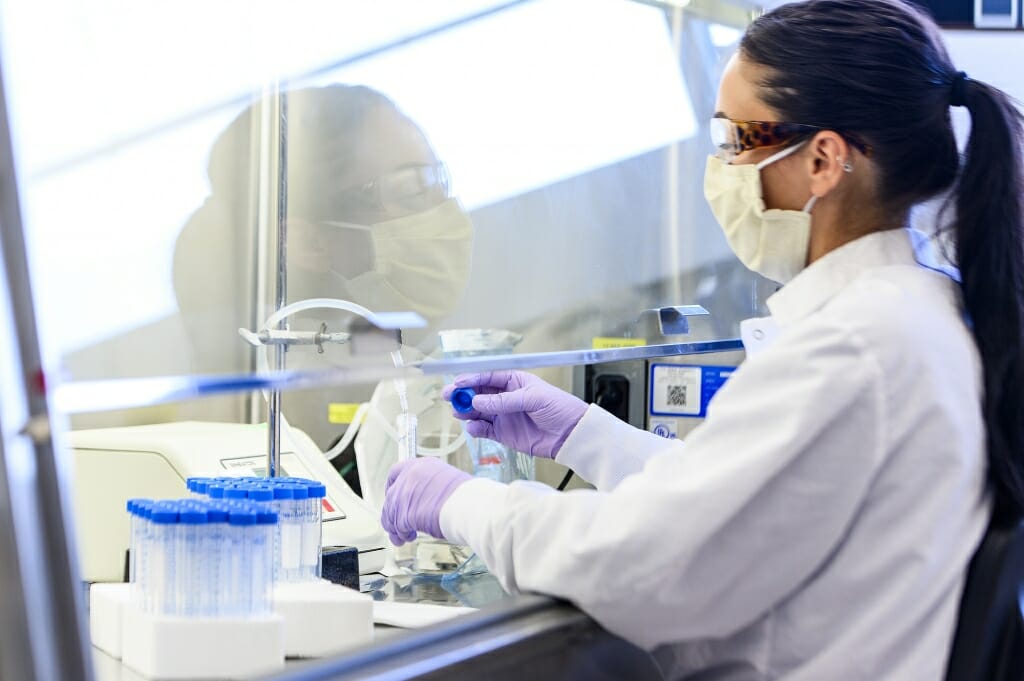
UW student Megan Skoyen dispenses viral transport media for COVID-19 test kits that are being created at the Wisconsin Veterinary Diagnostic Lab on July 2, 2020. The WVDL is partnering with the Wisconsin State Lab of Hygiene, University Health Services, the School of Medicine and Public Health, and others on campus to set up widespread COVID-19 testing for all students, faculty and staff in preparation to reopen the campus this fall. Photo: Bryce Richter
In the early days of the pandemic, when labs across the country were struggling to meet the demand for testing supplies and materials, the Wisconsin Veterinary Diagnostic Laboratory immediately took action. The state’s leading animal health lab provided COVID-19 test kits, scarce materials, equipment and training to the Wisconsin State Laboratory of Hygiene, which performs COVID-19 testing for high-priority patients statewide.
Now, the two labs are coming together again in support of University of Wisconsin–Madison efforts to provide free COVID-19 testing to the entire campus community. The goal is to identify infections, isolate and care for those who are sick, and limit the spread of the disease as campus moves forward with a modified re-opening plan.
By the beginning of the fall semester on September 2, UW–Madison will offer no-cost testing to all students, faculty and staff, with some testing set to begin in early August.
The full campus plan also includes regular screening of UW Housing residents and employees and surveillance testing among volunteer groups of students and employees from representative areas of campus. This approach will allow campus to rapidly identify and isolate potential cases, including among people who may not exhibit symptoms of COVID-19, helping to curb disease transmission.
Testing will augment other UW–Madison efforts to keep the community safe, including a face covering requirement in all indoor and some outdoor locations; changes to ensure physical distancing; reduced density in campus spaces, including classrooms; and enhanced cleaning protocols.
“I think the culture … and the type of expertise that we have on this campus with infectious disease testing and management, really, it creates a great foundation for a partnership like this to flourish,” says Keith Poulsen, director of the veterinary diagnostic lab, noting the unique relationships across campus that make the plan possible.
To perform human diagnostic tests, laboratories need federal Clinical Laboratory Improvement Amendments, or CLIA, certification. At UW–Madison, the Wisconsin State Lab of Hygiene and University Health Services are the only entities with such credentials (University of Wisconsin Hospital and Clinics is also CLIA certified).
However, as the state’s public health laboratory, WSLH is responsible for processing a significant number of COVID-19 tests from patients across Wisconsin. It was not possible for WSLH to take on the full testing needs of campus. Given the existing relationship between the two labs, and WVDL’s national expertise in large-scale diagnostic disease testing, early conversations between colleagues led to the idea that WVDL might be able operate under WSLH’s license.
“It was clear we had to set up some on-campus capacity in order to meet the demands that would be made by reopening the campus and bringing back students, staff and faculty,” says campus testing lead Norman Drinkwater, who retired as UW–Madison vice chancellor for research and graduate education last fall and is an emeritus professor of oncology. “The one that we settled on is a partnership between WSLH and WVDL, where WVDL would have the ability to establish the high-complexity testing that was required and would have the oversight of WSLH as a CLIA certified human diagnostics laboratory.”
The plans for campus testing include three components: establishing multiple sites across campus for any employee or student who desires a COVID-19 test; a mandatory screening program to identify and contain potential infections in residence halls; and volunteer cohorts of individuals across representative campus populations that will provide regular samples to assist campus and public health officials monitor for the prevalence of disease. The WVDL expects it can run more than 6,000 tests per week.
“This gives us an ability to see over time if things are changing,” says Jonathan Temte, associate dean for public health and community engagement at the UW School of Medicine and Public Health, who is part of the testing work group on campus. “It will help us determine when it might be necessary to suggest changes to campus operations.”
Testing also helps officials identify people at risk of developing the disease so they can enter into self-quarantine and monitor themselves for symptoms, limiting their contact with others.
“This three-layered strategy is as comprehensive as I have seen, in a methodical way, and will provide us actual material we can use on both a campus and individual level,” says testing group member Jake Baggott, associate vice chancellor and executive director of University Health Services at UW–Madison. “It’s bringing a lot of really talented people and important resources together to come up with a plan under trying circumstances.”
In Wisconsin, as in many states across the country, cases of COVID-19 are on the rise, including among the college-age population. UW–Madison, while preparing for some face-to-face instruction and an increase in research activity, is also poised to consider alternatives to in-person operations should local, state or national conditions warrant. Campus is closely monitoring the situation.
That is, says Poulsen, one of the several advantages to the campus testing plan.
“How will (the circumstances) change and how will we adapt to be agile to do that?” he says. “That’s where our weekly updates and strategic planning (come in) to make sure we’re using resources appropriately to really serve the campus community.”
As of mid-July, WVDL is in the process of procuring and validating the necessary equipment per the standards set forth by CLIA regulations, training staff, hiring new microbiologists, preparing test kits, and preparing to begin testing. The lab is working with the UW Biotechnology Center to scale up and automate testing so it can handle a high volume.
The polymerase chain reaction test campus will use is well-validated for COVID-19 diagnostics and relies on detecting the genetic material of the virus from nasal swab samples collected from symptomatic and asymptomatic people. It’s also a test WVDL is familiar with running because many viral diseases that affect animals, including other coronaviruses related to COVID-19, are detected using PCR.
Doing in-house testing, says Jan Klawitter, public affairs manager at WSLH, will help keep costs down relative to sending samples to a commercial lab.
Thanks to its close relationship with Public Health Madison and Dane County, UHS will facilitate ongoing communications with local and statewide health officials, sharing campus-level data. It will continue to connect students with testing, hire additional health care and public health providers to assist in case management, and perform contract tracing to help identify anyone exposed to individuals on campus who may test positive for COVID-19.
However, the testing leaders say, individual behaviors will ultimately guide the trajectory of the fall semester. Testing is intended to help keep abreast of and inform those developments.
“Public Health Madison and Dane County has shown a commitment to providing widespread testing and we are glad to join them as partners in helping keep our community safe,” Baggott says. “As (viral) activity comes on and students come back, that will stress the human diagnostic capacity. That’s why we need to do our part … People’s individual actions contribute to our success and failure, and the more data we have, the more ability we have to reinforce that locally.”
In addition to campus testing, with more details to be announced soon, students can contact UHS if they need a COVID-19 test. Members of the campus community, including students, can also pursue free COVID-19 testing at the Alliant Energy Center, at least through August 31, 2020, and at community sites throughout the city and county. Additionally, symptomatic individuals may seek testing through their medical providers.
COVID-19 symptoms include: Fever or chills, cough, shortness of breath or difficulty breathing, fatigue, muscle or body aches, headache, new loss of taste or smell, sore throat, congestion or runny nose, nausea or vomiting, diarrhea. Symptoms may appear two-to- 14 days after exposure to the virus.
Other partners in campus testing include the Office for Research and Graduate Education, the Office of Legal Affairs and UW System.

